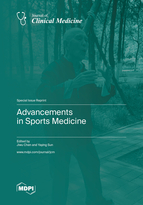Advancements in Sports Medicine
A special issue of Journal of Clinical Medicine (ISSN 2077-0383). This special issue belongs to the section "Sports Medicine".
Deadline for manuscript submissions: closed (15 August 2022) | Viewed by 22943
Special Issue Editors
Interests: sports medicine; sports and health; orthopedics
Special Issues, Collections and Topics in MDPI journals
Interests: orthopedics; sports medicine; sports and health
Special Issues, Collections and Topics in MDPI journals
Special Issue Information
Dear Colleagues,
The recent progress in the field of sports medicine is remarkable. Many hot topics, such as rotator cuff repair, anterior cruciate ligament reconstruction, and hip arthroscopy, have acquired a great deal of attention, with numerous investigations being reported in the literature. Novel understandings of anatomy are enabling a great evolution of surgical concepts and practices. In addition, conservative modalities against sports injuries such as platelet-rich plasma have been widely used clinically, with considerable experience accumulated to date. Recent years have also witnessed the proposal and promotion of the slogan “Sports is Medicine”, which encourages cooperation between disciplines. In this Special Issue, we welcome authors to submit papers on clinical advancements in sports medicine, and on the relationships between sports medicine and other disciplines.
Prof. Dr. Jiwu Chen
Dr. Yaying Sun
Guest Editors
Manuscript Submission Information
Manuscripts should be submitted online at www.mdpi.com by registering and logging in to this website. Once you are registered, click here to go to the submission form. Manuscripts can be submitted until the deadline. All submissions that pass pre-check are peer-reviewed. Accepted papers will be published continuously in the journal (as soon as accepted) and will be listed together on the special issue website. Research articles, review articles as well as short communications are invited. For planned papers, a title and short abstract (about 100 words) can be sent to the Editorial Office for announcement on this website.
Submitted manuscripts should not have been published previously, nor be under consideration for publication elsewhere (except conference proceedings papers). All manuscripts are thoroughly refereed through a single-blind peer-review process. A guide for authors and other relevant information for submission of manuscripts is available on the Instructions for Authors page. Journal of Clinical Medicine is an international peer-reviewed open access semimonthly journal published by MDPI.
Please visit the Instructions for Authors page before submitting a manuscript. The Article Processing Charge (APC) for publication in this open access journal is 2600 CHF (Swiss Francs). Submitted papers should be well formatted and use good English. Authors may use MDPI's English editing service prior to publication or during author revisions.
Keywords
- sports medicine
- clinical study
- surgical intervention
- conservative treatment
- anatomical finding
- multi-disciplinary research








